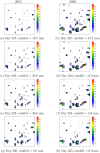A Regional Model for Malaria Vector Developmental Habitats Evaluated Using Explicit, Pond-Resolving Surface Hydrology Simulations
- PMID: 27003834
- PMCID: PMC4803214
- DOI: 10.1371/journal.pone.0150626
A Regional Model for Malaria Vector Developmental Habitats Evaluated Using Explicit, Pond-Resolving Surface Hydrology Simulations
Abstract
Dynamical malaria models can relate precipitation to the availability of vector breeding sites using simple models of surface hydrology. Here, a revised scheme is developed for the VECTRI malaria model, which is evaluated alongside the default scheme using a two year simulation by HYDREMATS, a 10 metre resolution, village-scale model that explicitly simulates individual ponds. Despite the simplicity of the two VECTRI surface hydrology parametrization schemes, they can reproduce the sub-seasonal evolution of fractional water coverage. Calibration of the model parameters is required to simulate the mean pond fraction correctly. The default VECTRI model tended to overestimate water fraction in periods subject to light rainfall events and underestimate it during periods of intense rainfall. This systematic error was improved in the revised scheme by including the a parametrization for surface run-off, such that light rainfall below the initial abstraction threshold does not contribute to ponds. After calibration of the pond model, the VECTRI model was able to simulate vector densities that compared well to the detailed agent based model contained in HYDREMATS without further parameter adjustment. Substituting local rain-gauge data with satellite-retrieved precipitation gave a reasonable approximation, raising the prospects for regional malaria simulations even in data sparse regions. However, further improvements could be made if a method can be derived to calibrate the key hydrology parameters of the pond model in each grid cell location, possibly also incorporating slope and soil texture.
Conflict of interest statement
Figures






Similar articles
-
A breeding site model for regional, dynamical malaria simulations evaluated using in situ temporary ponds observations.Geospat Health. 2016 Mar 31;11(1 Suppl):390. doi: 10.4081/gh.2016.390. Geospat Health. 2016. PMID: 27063734
-
The effect of explicit convection on simulated malaria transmission across Africa.PLoS One. 2024 Apr 16;19(4):e0297744. doi: 10.1371/journal.pone.0297744. eCollection 2024. PLoS One. 2024. PMID: 38625879 Free PMC article.
-
A regional-scale, high resolution dynamical malaria model that accounts for population density, climate and surface hydrology.Malar J. 2013 Feb 18;12:65. doi: 10.1186/1475-2875-12-65. Malar J. 2013. PMID: 23419192 Free PMC article.
-
[Review on HSPF model for simulation of hydrology and water quality processes].Huan Jing Ke Xue. 2012 Jul;33(7):2217-23. Huan Jing Ke Xue. 2012. PMID: 23002594 Review. Chinese.
-
High-resolution observations from space to address new applications in hydrology.Innovation (Camb). 2023 Apr 28;4(3):100437. doi: 10.1016/j.xinn.2023.100437. eCollection 2023 May 15. Innovation (Camb). 2023. PMID: 37215525 Free PMC article. Review. No abstract available.
Cited by
-
Investigating the Impact of Irrigation on Malaria Vector Larval Habitats and Transmission Using a Hydrology-Based Model.Geohealth. 2023 Dec 10;7(12):e2023GH000868. doi: 10.1029/2023GH000868. eCollection 2023 Dec. Geohealth. 2023. PMID: 38089068 Free PMC article.
-
Effects of Climate Variability on Malaria Transmission in Southern Côte d'Ivoire, West Africa.Int J Environ Res Public Health. 2023 Nov 23;20(23):7102. doi: 10.3390/ijerph20237102. Int J Environ Res Public Health. 2023. PMID: 38063532 Free PMC article.
-
Bias-Corrected CMIP5 Projections for Climate Change and Assessments of Impact on Malaria in Senegal under the VECTRI Model.Trop Med Infect Dis. 2023 Jun 6;8(6):310. doi: 10.3390/tropicalmed8060310. Trop Med Infect Dis. 2023. PMID: 37368728 Free PMC article.
-
Climate Drivers of Malaria Transmission Seasonality and Their Relative Importance in Sub-Saharan Africa.Geohealth. 2023 Jan 29;7(2):e2022GH000698. doi: 10.1029/2022GH000698. eCollection 2023 Feb. Geohealth. 2023. PMID: 36743738 Free PMC article.
-
Spatiotemporal patterns of diarrhea incidence in Ghana and the impact of meteorological and socio-demographic factors.Front Epidemiol. 2022;2:871232. doi: 10.3389/fepid.2022.871232. Epub 2022 Apr 8. Front Epidemiol. 2022. PMID: 35822109 Free PMC article.
References
-
- Fillinger U, Sonye G, Killeen GF, Knols BGJ, Becker N. The practical importance of permanent and semipermanent habitats for controlling aquatic stages of Anopheles gambiae sensu lato mosquitoes: operational observations from a rural town in western Kenya. Tropical Medicine & International Health. 2004;9(12):1274–1289. 10.1111/j.1365-3156.2004.01335.x - DOI - PubMed
-
- Minakawa N, Sonye G, Yan G. Relationships between occurrence of Anopheles gambiae sl (Diptera: Culicidae) and size and stability of larval habitats. Journal of medical entomology. 2005;42(3):295–300. - PubMed
-
- Mutuku FM, Bayoh MN, Gimnig JE, Vulule JM, Kamau L, Walker ED, et al. Pupal habitat productivity of Anopheles gambiae complex mosquitoes in a rural village in western Kenya. The American journal of tropical medicine and hygiene. 2006;74(1):54–61. - PubMed
-
- Awolola T, Oduola A, Obansa J, Chukwurar N, Unyimadu J. Anopheles gambiae ss breeding in polluted water bodies in urban Lagos, southwestern Nigeria. Journal of Vector Borne Diseases. 2007;44(4):241 - PubMed
Publication types
MeSH terms
Substances
Grants and funding
LinkOut - more resources
Full Text Sources
Other Literature Sources
Medical

